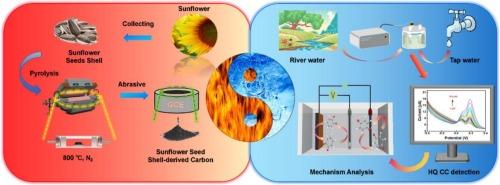从农业废弃物到先进的电化学界面:利用向日葵衍生碳选择性检测对苯二酚和儿茶酚
IF 4.9
2区 化学
Q1 CHEMISTRY, ANALYTICAL
引用次数: 0
摘要
在这项研究中,利用从葵花籽壳中提取的多孔碳开发了一种超灵敏、经济高效、环境可持续的电化学传感器,用于同时检测对苯二酚(HQ)和儿茶酚(CC),这两种有毒的酚类污染物经常出现在工业废水中。碳材料的合成采用直接的单步热解工艺,不需要化学活化或金属添加剂,符合绿色化学和资源增值的原则。采用SEM、EDS、XRD、FTIR和拉曼光谱对碳的结构和表面化学性质进行了全面表征。大量含氧官能团的存在和自然保留的KCl有助于提高碳的表面反应性和导电性。制备的电极具有氧化还原峰分离明显、灵敏度高、响应速度快、抗干扰能力强等优点,可同时检测HQ和CC。在优化条件下,该传感器对两种分析物的线性检测范围均为0.5 ~ 400 μM,对HQ和CC的检出限分别为3.24 nM和1.95 nM,在河流和自来水样品中验证了该传感器的实用性,回收率在97.25% ~ 106.42%之间,与高效液相色谱(HPLC)结果非常吻合。这项工作强调了将农业废弃物转化为高性能碳基传感平台用于实时环境污染物监测的可行性本文章由计算机程序翻译,如有差异,请以英文原文为准。

From agro-waste to advanced electrochemical interface: Selective detection of hydroquinone and catechol using sunflower-derived carbon
In this study, an ultrasensitive, cost-effective, and environmentally sustainable electrochemical sensor was developed using porous carbon derived from sunflower seed shells for the simultaneous detection of hydroquinone (HQ) and catechol (CC), two toxic phenolic pollutants frequently present in industrial effluents. The carbon material was synthesized through a direct, single-step pyrolysis process that required no chemical activation or metal additives, aligning with the principles of green chemistry and resource valorization. The structural and surface chemical properties of the carbon were comprehensively characterized using SEM, EDS, XRD, FTIR, and Raman spectroscopy. The presence of abundant oxygen-containing functional groups and naturally retained KCl contributed to the enhanced surface reactivity and electrical conductivity of the resulting carbons. The fabricated electrode exhibited excellent performance in simultaneously detecting HQ and CC, with distinct redox peak separation, high sensitivity, rapid response, and strong anti-interference capability. Under optimized conditions, the sensor achieved wide linear detection range of 0.5–400 μM for both analytes and ultralow detection limits of 3.24 nM for HQ and 1.95 nM for CC. The practical applicability of the sensor was validated using river and tap water samples, yielding recovery rates between 97.25 % and 106.42 %, which were in excellent agreement with high-performance liquid chromatography (HPLC) results. This work underscores the feasibility of converting agricultural waste into high-performance carbon-based sensing platforms for real-time environmental pollutant monitoring
求助全文
通过发布文献求助,成功后即可免费获取论文全文。
去求助
来源期刊

Microchemical Journal
化学-分析化学
CiteScore
8.70
自引率
8.30%
发文量
1131
审稿时长
1.9 months
期刊介绍:
The Microchemical Journal is a peer reviewed journal devoted to all aspects and phases of analytical chemistry and chemical analysis. The Microchemical Journal publishes articles which are at the forefront of modern analytical chemistry and cover innovations in the techniques to the finest possible limits. This includes fundamental aspects, instrumentation, new developments, innovative and novel methods and applications including environmental and clinical field.
Traditional classical analytical methods such as spectrophotometry and titrimetry as well as established instrumentation methods such as flame and graphite furnace atomic absorption spectrometry, gas chromatography, and modified glassy or carbon electrode electrochemical methods will be considered, provided they show significant improvements and novelty compared to the established methods.
 求助内容:
求助内容: 应助结果提醒方式:
应助结果提醒方式:


